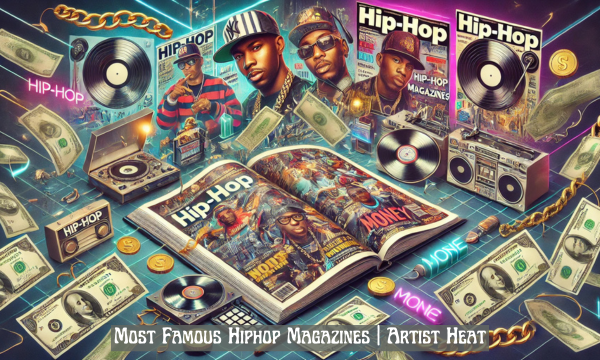Hey there, fellow hip-hop heads! To be more precise, today I’ll be exploring music journalism focusing on hip hop – those golden age magazines defining this very culture we enjoy to this date. It is more than magazines; it is history that captured the growth of hip-hop culture from a subculture to worldwide culture. So, let me rid you from these illusions and describe what makes these publications unique, and what they are good and bad at.
The Source: The Hip-Hop Bible That Started It All
In 1988, two students of Harvard university started what could be considered the script of hip-hop journalist. It wasn’t just a magazine; The Source was the first legitimate platform whose relevance spanned the African American community’s culture.
The Five-Mic Legacy
.pop music’s rating, that The Source magazine established the current five-mic rating system for hip-hop albums. Many artists for instance would be running to the editors begging to be given that perfect score. However, this was to change with perception that some programmes got favoured ratings based on relations and politics and not their quality.
The Fall from Grace
Some of the major setbacks which occurred with the magazine were experienced in early 2000s with the emergence of Dave Mays and Benzino. Their bitter rivalry with Eminem illustrated that outside grudges and rivalries could get in the way of professionalism. It was circulating about 500’000 monthly copies and this drastically decreased after these controversies.
The Source exists today but the company is struggling to exist in today’s society mainly because of the advancement in technology. They geared up for a more diverse structure online presence, however, their visitor traffic is insignificant in comparison to other platforms appealing 1 to 2 million visitors as compared to complex more than 50 million.
XXL: The New School Giant That Became a Classic
When The Source began its decline, XXL stepped up to fill the void. Launched in 1997, XXL quickly established itself as a serious contender.
Freshman Class: A Star-Making Machine
In 2007, XXL hit the jackpot with what many have regarded as their crowning compilation series: Freshman Class. This single franchise changed XXL from just any other magazine to a cultural leader. It began with some of the greatest acts in the game such as Kendrick Lamar, J. Cole and Lil Uzi Vert among others, thereby creating the cred that XXL always has the best talents.
Print’s Last Stand
Today the magazine stills has a quarterly print edition, however circulation and readership numbers hardly reflect the heyday of XXL – that was 300 000 copies against of today’s 100 000 and fewer. The website receives around 5-8 million unique visitors per month, however, the most interaction is held on social networks where the Freshman Class cyphers and freestyles gain tens of millions of views.
Today, XXL Magazine completely depends on such opportunities as branded content partnerships, events and their rather promising social media aspect instead of ads.
Vibe: Where Hip-Hop Meets High Culture
When Quincy Jones undertook the creation of Vibe in 1993, he intended to create a glossy magazine that would bring the showcase of hip-hop as rolling stone brought for rock and roll. Vibe was upscale in both look and content, it brought a hip-hop aesthetics to music journalism.
Beyond the Music
Vibe differentiated itself thanks to the editorial direction that addressed fashion, film, politics, among others, as the hip-hop lens through which readers should approach the world. Their photography and design set new standards for the industry.
The Tupac Interview
It featured some of the groundbreaking interviews of the legendary rappers, and perhaps the most causing a stir in 1995, the Tupac Shakur prison interview. This interview was provocative and critical, proving that Vibe was willing to report on music and musicians in a way that was not solely star-gazing.
The Identity Crisis
Over the years, the magazine has gone through many changes in corporate ownership and, therefore, has not been very coherent. Galler has 3-5 million users visits monthly, and they practically tried all forms of monetization from sponsored content to events to survive. After a two and a half decade long run, the magazine was ceased in 2018 and it’s a fully digital format now.
Complex: The Digital-First Revolution
However, unlike Complex which has been labelled a magazine, it was created for the Internet. The magazine that began in New York City in 2002 by Marc Ecko, Complex rose to become much more than just a fashion magazine.
Content Factory
Egotastic redefined hip-hop journalism for Generation Shareability, listicles, and YouTube series such as Hot Ones and Sneaker Shopping. It is quite impressive when we talk about their traffic; the average monthly visitor is 50 million while there are billions of video views per year.
The Controversy Machine
The publications’ critics say Complex mainly focuses on the traffic, and it can provoke unnecessary beef or controversies sometimes. This they have done by simply escalating every social media freakishness the world has come to know them as TMZ rather than journalism.
The Money Move
This business model was good so good that Verizon and Hearst acquired Complex for three hundred million dollars in the year 2016 which shows that the thinking of having a digital first approach was correct. They have also ventured in aspects such as the ComplexCon which is a highly revenue generating market.
Rap-Up: The Underdog Success Story
While discussing the hip-hop media titans, a little magazines worth mentioning is the Rap-Up. Established in 200 by Devin Lazerine who was at that time a teenager, Rap-Up initially started as a website and later morphed into a magazine in 2004.
The News-First Approach
Whereas other outlets provided their readers with features, reviews, Rap-Up positioned itself in the realm of exclusives – being the first to report album releases, single leaks and video-premieres. Through simple and direct, they managed to attract a customer base that was quite dedicated.
The Digital Transition
In fact, the idea marks a strategic move by Rap-Up to adapt to digital-only at an earlier time than many of its competitors. This has given them a comparative advantage compared to large multipurpose websites such as Complex.com that has made them to adapt in the unstable media environment. It garners a decent 3-4 million monthly readership figures, quite significant for an organization that does not report to any professional journalism association.
The Monetization Game: How Hip-Hop Media Makes Money
They barely speak of a progressive dynamic in hip-hop journalism in comic books and several other now clichéd fields, which have emerged over the decades. These magazines were mainly dependent on the sales of these magazines from the stands, subscriptions and advertisement on print media. It stated that during The Source’s heyday, a single full-page ad could cost $50,000+;.
Today, the revenue streams are far more diverse:
Digital Advertising
The three primary forms of advertising in most of the journalism publications today are the banners, ads before the video, and sponsored content. Complex is said to make more than $100 million market on annual basis from the digital advertising only.
Events and Experiences
It was also noted that ComplexCon draws brings an estimated $30 million for each weekend it is held. Freshman Live tours and The Source awards show which are currently among the leading events important for generating revenues.
Content Licensing
Also, brands such as XXL and Complex have partnerships with platforms like Spotify and YouTube to distribute some of the content exclusively in shareable income streams.
E-Commerce
StockX, Complex’s former partial owner of its sneaker marketplace that was later spun off the division, this exemplified how content and commerce can generate tens of millions of dollars in revenue.
The Future: Adapt or Die
The most threatened type of magazines are not the ones with a long and respectable background but the ones with less integrity and less hesitation to change. Traffic and engagement have become the values that matter and valuable content is created only if it can find its place in the social site.
The best way for Hip-Hop journalism to thrive is for magazines to maintain their voice while trying to adapt to the new evolving business structures in a market which is constantly flooded with new players.
Magazines that forwarded hip hop culture are now in turn being transformed by it, struggling to exist when artists have instant access to an audience. It helps to ask questions that artists’ self-promotion doesn’t answer, or doesn’t answer insightfully, which is what the most successful publications are now doing.
Regardless of whether or not they remain as cultural stabilize-ed entities or are relegated to the annals of vintage culture, these magazines have etched their records in the great history of hip-hop. This is why they did not only capture the cultural moments, but contributed to shaping it as well.

